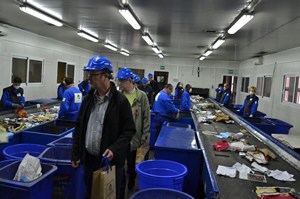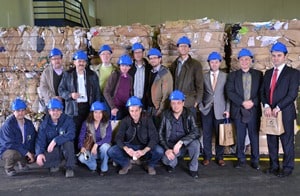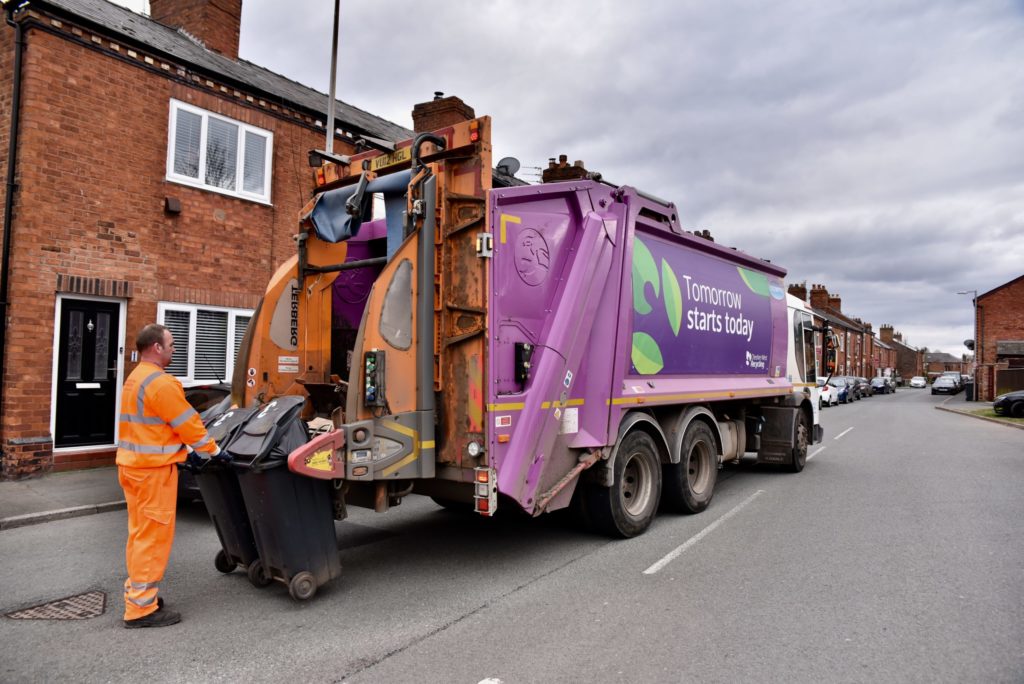The ISWA Recycling and Waste Minimisation Working Group met in Thessaloniki, Greece in November 2011 as the new government was starting to be formed and at the end of the 52nd Thessaloniki International Film Festival. Of greater importance to theWorking Groupwas the fact that Thessaloniki was launching its household recycling scheme and was using local schools for its main outreach and education programme headed up in person by the mayor, Yiannis Boutaris who is also a noted winemaker and whose products we had the pleasure of sampling during our visit. Indeed our first day of discussions were hosted by him in his official meeting room in the new municipal offices.
Thessaloniki is the second largest city in Greece with a population of 750,000 but the metropolitan area covers 1.3m people. Greece has a total population of about 10m. The results of this years census are still being analysed. However, it is estimated that there are in excess of 1 million illegal immigrants who have come from the north, south and east and for whom scraping a living from the collection and selling of recyclable wastes may be their only source of income. There are, in addition a large number of poorer and older people now faced with real reductions in their incomes, often with pensions as low as 300 a month.
Extended Producer Responsibility in Greece
Katia Lasaridi is an Associate Professor at Harokopio University in Athens but more importantly she is also the president of the National Organisation for the Alternative Management for Packaging and Other Wastes (NOAMPOW). Fortunately there has been a new law which may provide the opportunity for a name change to make everyones life easier! Alternative means alternative to landfill or more accurately for much of Greece dumping and periodic fires releasing dioxins that are many times more dangerous than controlled incineration or co-incineration but too many of the Greek population have grown up with burning waste dumps to be worried by it but fear the cleaner alternative of energy from waste.
Professor Lasaridi is effectively therefore in charge of all the extended producer responsibility waste streams for Greece. In addition to the EU Directive wastes affected by EPR Greece has placed producer responsibility on lubricating oils, tyres and very recently construction and demolition waste.
The origin of EPR regulation in Greece is based on legislation passed in 2001, Law 2939/2001 designed to implement the EU Packaging and Packaging Waste Directive but also any other forthcoming EPR Directive. In the case of the Packaging Directive Greece was given an extension in meeting the targets for both the original 1994 Directive and the 2004 revised directive so that it has to achieve the 60% recovery and 55% recycling targets and the material specific targets in 2011.
The main packaging compliance scheme or for Greece Collective Alternative Management System (CAMS-Recycling) is HERRCo (Hellenic Recovery Recycling Corporation). In common with most other systems in the EU HERRCo has adopted the Green Dot system. By the end of 2010 there were more than 1,650 companies which had joined HERRCo, representing the major proportion of the Greek packaging market. Combined their packaging placed on the market comes to just short of half a million tpa, a figure unlikely to be exceeded in the next few years.

The number of municipalities participating in the HERRCo system at the end of 2010 was 679 (however this is a figure that represents the old local government system before it was revised and the number of municipalities considerably reduced in late 2010). However, the population of Greece covered by the HERRCo collections is almost 80% of the total. These municipalities have been provided with about 110,000 blue bins of 1,000 litre capacity and 360 collection vehicles, mainly 16m3 load capacity.
These collection systems deliver into a number of Recycling Sorting Centres (RSCs). The total at the beginning of 2011 was 28 with 6 new ones being added in 2010. on the second day we visited one of the longer established of these RSCs at a neighbouring municipality, Thermi (see below).
In common with the UK there is the opportunity to establish multiple compliance schemes, provided they receive the approval of NOAMPOW. At present there are 4 approved systems in Greece for packaging, including: one operated by the largest of the supermarket chains and another relying on reverse-vending machines, which appears to have large throughput at very low cost. As for the other waste streams: WEEE has 4 systems, batteries 3, ELVs 1, lubricating oil 1, tyres 1 and although the most recent C&D 3 systems.
Again, as with the UKs compliance schemes there are opportunities to improve their performance by for example collaborating with other packaging organisations, specialised collection facilities for hotels, bars and other packaging waste generators and buying in evidence from the C&I reclamation and reprocessing sectors. HERRCo therefore has all of these options available but in addition also reclaims non-packaging paper products despite their not having any EPR obligations. Therefore in 2010, for example, the total of packaging waste from the blue bin/municipal collections amounted to 183,000 tonnes and nearly 95,000 tonnes of printed matter and altogether through its other activities HERRCo could claim 511,000 of recyclable materials going through their system.
The municipal/blue bin recovery rate while increasing from 173 to 183,000 tonnes between 2009 to 2010 showed a definite plateau effect because at 22kg pp recovery rate it was the same as the previous year and from 2008 to 2009 the increase was from 117 to 173,000 tonnes. The recessionary pressures were and are still considerable in Greece so 2011 may show a slight decline.
The influence of the mayor
In discussion it transpired that the mayor of the municipality has huge influence in determining the fate of the development of recycling initiatives in Greece. If the mayor decides to support recycling then the municipality can develop a number of initiatives. However, frequently the mayor says no and it often therefore takes the efforts of a large number of volunteers to make up the environmental deficit, as in the island of Sciathos, for example.
However Katia Lasaridi did state that Greece had collected 31% of its portable batteries that were discarded during the past year, a remarkable feat given the large number of islands and extensive mountainous areas, which have obvious logistical problems for the country. The reason for being able to achieve this Professor Lasaridi suggested was the fact that there was no municipality involvement.
For ELVs there is no problem with more than 80% of ELVs being treated in Greece compared to Austria and Germany where only 20-25% of ELVs are treated with the remainder going over the frontiers as near ELVs. For tyres there is one company shredding and chipping tyres. Despite the number of cement kilns in Greece few tyres are actually permitted to be processed in them such is the public opposition to this treatment method. Export is the main route but there seems to be a black hole as far as routes and destinations are concerned.
Greeces financial problems have had a huge impact on the countrys potential compliance with EU EPR Directive targets. This has affected both the producers seeking to minimise their financial contributions but also the collection mechanisms for all types of wastes affected by EPR. Therefore HERRCo, the main packaging compliance scheme in 2010 placed a hold on the provision of any further assistance to new municipalities beyond those to which commitments had already been made.
For the collection initiatives, for instance, aluminium cans are now frequently scavenged from blue bins. In 2010 the amount of WEEE collected went down compared to the previous year, again due the theft and scavenging of WEEE, mainly to extract the valuable metal fractions, which is a problem now frequently experienced in most EU states.
The Thermi RSC
The Recycling Sorting Centre (RSC) in Thermi is one of the oldest within the Greek system for handling packaging waste. Having said that its development needed a considerable amount of discussion prior to opening and it only became fully operational in June 2007. the land on which the RSC was to be built was offered by the municipality of Thermi in an area zoned for industrial development, next to an army airfield and miles from the nearest habitations. Nevertheless there was huge opposition due to misinformation about the site being an open dump sited next to a school that achieved 1,500 signatures on a petition over 2 days.

The RSC building has been leased to HERRCo for 20 years and the equipment in the RSC was paid for by HERRCo together with 14 collection vehicles and 4,200 blue bins of 1,100 capacity. The equipment is very rudimentary with the main items of equipment in the RSC being the trommel, baler and the conveyors plus mobile plant. Most of the sorting is through manual means with even magnetic separation only in one section.
The plant takes in mixed dry recyclables collected from the blue bins, including glass and then separates these into different fractions. There are two pre-sort processes: the first on the ground where each load is deposited to remove any large contaminants or items while the second, at the top of the first conveyor takes out the glass and plastic film, both of which would cause problems later in the process.
The trommel then splits the material into small (<25mm) undersized items destined for landfill, the over sized (>250mm) mainly cardboard and the medium sized, mainly containers etc. The two recyclable streams are treated differently; the cardboard fraction is negatively sorted with anything which is not cardboard separated out while the other stream is positively sorted with anything recylcable: PET, HDPE and LDPE separated together with aluminium cans and steel cans are extracted by an overband magnet at the end of the sorting line. Anything left is rejected to landfill. Overall 30% of the input material is sent to landfill but even the best of the Greek RSCs has a 12-15% rejection rate.
Cardboard and paper is fed into the baler throughout the day and at the end of sorting operations the other fractions are baled except for steel cans which are delivered direct to a nearby scrap merchant. The plant processes about 15,000 tpa with just under 1,000 tonnes product output each month.
C&D Recycling
The plant which we saw operating on the extreme western fringes of the metropolitan area of Thessaloniki is only one of two plants operating to process C&D residues in Greece. Not unnaturally the other is located in Athens but operationally and in terms of product outputs its standards are reputedly much lower than the Thessaloniki plant.The plant is located at the bottom of quarry with total cost 12-15million for the plant and civil engineering works, which also included the planting of large numbers of trees and bushes around the site.
The plant was planned and constructed at a time before the financial crisis impacted and in a context where C&D waste is effectively banned from landfill, at least landfills that are permitted are not allowed to take in C&D waste in Greece, which means that providing daily cover becomes a big problem. Also when first constructed builders would bring waste to the site at non-operating hours and fly-tip it with the owner forced to process the waste but with no income although the gate fees are miniscule, partly because there is no landfill tax.
The only way that the plant has survived is because the owner has two other businesses: a construction company and one of the worlds most advanced asphalt plants. Therefore it is possible for him to bring in staff from these other operational units to operate the plant as and when necessary, currently less than one day each week given the current problems of the greek economy. The asphalt plant which is located close to the west of the Thessaloniki is new but the old plant on the same site is still operational at present.
The new facility only became fully operational in May 2011 and from then until our visit in November 2011 had produced 60,000 tonnes output of 0-12mm or 13-25mm of which 50% was from waste inputs. The cost savings of using waste, including asphalt/tar macadam amounts to about 22 per tonne compared to quarry products and other raw materials but obviously with the additional environmental benefits as well.
Input prices (in Euros) to the site are:
| Soil | 3.50 |
|---|---|
| Mixed C&D | 2.00 |
| Demolition waste sorted | 7.50 |
| Demolition waste not sorted | 10.00 |
| Waste from renovation work | 20.00 |
| Road excavation | 1.50 |
| Planings from road re-surfacing | FOC |
The outputs from the plant comprise predominantly fill material sold at 1.50 per tonne, there being no aggregates tax in Greece either. Nearly 50% of output is fill, 40% is 0-6mm, 6-12mm, 13-24mm and 25mm or mixtures of these sizes. The remaining 10% of output is ferrous metal, paper, plastics, aluminium, and glass, mainly sent to RSCs for further processing. Only 2-3% is sent to landfill.
Conclusions
Overall, while Greece is obviously suffering from the Euro crisis there are many good initiatives that are being pursued at a local level in order to ensure the Greece can fulfil its obligations under the EUs environmental Directives. Our visit to Thessaloniki demonstrated that while many of the collection and reclamation systems seem very rudimentary by North West European standards the C&D waste processing facility showed that there were advances that many waste managers in those countries could learn from. Greek hospitality, food and wine was excellent as always.











Subscribe for free